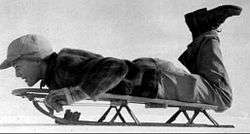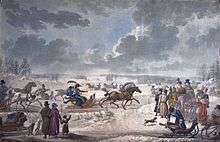Sled


A sled, sledge, or sleigh is a land vehicle with a smooth underside or possessing a separate body supported by two or more smooth, relatively narrow, longitudinal runners that travels by sliding across a surface. Most commonly sleds are used on snow or ice, however in certain cases they may be used on any surfaces, especially on ones with relatively low friction, such as sand or wet grass. They may be used to transport passengers, cargo, or both. Shades of meaning differentiating the three terms often reflect regional variations depending on historical uses and prevailing climate.
In Britain sledge is the general term, and more common than sled.[1] Toboggan is sometimes used synonymously with sledge but more often to refer to a particular type of wooden sledge with two runners.[2] Sleigh refers to a moderate to large-sized, usually open-topped vehicle to carry passengers or goods, and typically drawn by horses or dogs.[3] In Scandinavia particularly a sleigh may also be drawn by reindeer, as for Father Christmas.
In American usage sled remains the general term but often implies a smaller device, often for recreational use. Sledge implies a heavier sled used for moving freight or massive objects (syn. "stone boat"). Sleigh refers more specifically than in Britain to a vehicle which is essentially a cold-season alternative to a carriage or wagon and has seating for passengers; what can be called a dog-sleigh in Britain is known only as a dog-sled in North America.
In Australia, where there is limited snow, sleigh and sledge are given equal preference in local parlance.[4]
Etymology

The word sled comes from Middle English sledde, which itself has the origins in Old Dutch word slee, meaning "sliding" or "slider". The same word shares common ancestry with both sleigh and sledge.[5] The word sleigh, on the other hand, is an anglicized form of the modern Dutch word "slee" and was introduced to the English language by Dutch immigrants to North America [6]
Types of sleds
Sleds for recreational sledding

There are several types of widely used recreational sleds designed for sliding down snowy hills (sledding):[8]
- Toboggan, an elongated sled without runners, usually made from wood or plastic[9]
- Saucer, a round sled curved like a contact lens, also without runners and usually made out of plastic or metal
- Steel runner sled or flexible flyer, a steerable wooden sled with thin metal runners[10]
- Kicksled or spark, a human-powered sled
- Inflatable sled or tube, a plastic membrane filled with air to make a very lightweight sled
- Foam slider, a flat piece of durable foam with handles and a smooth underside
- Backcountry sled, a deep, steerable plastic sled to kneel on with pads and a seatbelt, such as the Mad River Rocket.
Sleds for competitive sledding
A few types of sleds are used only for a specific sport:
- Bobsled (British bobsleigh), an aerodynamic composite bodied vehicle on lightweight runners
- Luge and the skeleton, tiny one or two-person sleds with runners[11][12]
Various types of sleds are pulled by animals such as reindeer, horses, mules, oxen, or dogs.
Other sleds

- Airboard, an inflatable single-person sled, similar to a hovercraft[13][14]
- A cutter is a North American type of small horse-drawn sled[15]
- Troika, a vehicle drawn by three horses, usually a sled, but it may also be a wheeled carriage
- In some regions, "sled" [16] is colloquial slang for a snowmobile
- In arctic regions, the Inuit qamutiq is uniquely adapted for travel on the sea ice[17]
- Ahkio or pulka, a traditional sled of the Lapland region, originally pulled by reindeer; now more common as a human or snowmobile-towed sled often used for cold weather expeditions by mountain rescue teams and military cold weather units to haul equipment, supplies, and passengers
- In truck and tractor pulling, an implement pulled behind the machine which uses friction to stop the machine.[18]
Historical uses


The people of Ancient Egypt are thought to have used sledges extensively in the construction of their public works, in particular for the transportation of heavy obelisks.
Sleds and sledges were found in the Oseberg "Viking" ship excavation. Sledges were useful not only in winter but can be drawn over wet fields, muddy roads, and even hard ground, if one helps them along by greasing the blades with oil or alternatively wetting them with water; in cold weather the water will freeze to ice and they glide along more smoothly with less effort to pull them. The sledge was also highly prized, because – unlike wheeled vehicles – it was exempt from tolls.
Until the late 19th century, a closed winter sled, or vozok, provided a high-speed means of transport through the snow-covered plains of European Russia and Siberia. It was a means of transport preferred by royals, bishops, and boyars of Muscovy. Several royal vozoks of historical importance have been preserved in the Kremlin Armoury.
Man-hauled sledges were the traditional means of transport on British exploring expeditions to the Arctic and Antarctic regions in the 19th and early 20th centuries. Dog sleds were used by most others, such as Roald Amundsen. Today some people use kites to tow exploration sleds in such climes.
See also
References
- ↑ "Collins 2012 digital edition".
- ↑ "Collins 2012 digital edition".
- ↑ "Collins 2012 digital edition".
- ↑ The Macquarie Dictionary, 2nd ed.,. North Ryde: Macquarie Library. 1991.
- ↑ "thefreedictionary entrance on "sled"". Farlex.
- ↑ "thefreedictionary entrance on "sleigh"".
- ↑ Bogomolets O. Radomysl castle-Museum on the Royal Road Via Regia. — Kyiv, 2013
- ↑ Parigon Sleds
- ↑ "Hörnerschlitten" (in German). www.schlitten-bob.de. Retrieved 19 May 2013.
- ↑ "Snow Racer von Stiga finden Sie in der Rubrik Stiga Schlitten!" (in German). www.schlitten-bob.de. Retrieved 19 May 2013.
- ↑ "Herzlich Willkommen !" (in German). www.schlittendiscount.de. Retrieved 19 May 2013.
- ↑ "Hörnerschlitten" (in German). www.hoernerrodel.de. Retrieved 19 May 2013.
- ↑ "Klappschlitten" (in German). www.hoernerrodel.de. Retrieved 19 May 2013.
- ↑ "Lenkbob" (in German). www.schlittendiscount.de. Retrieved 19 May 2013.
- ↑ "Outram's Cutter MFG". Retrieved 5 November 2012.
- ↑ sledspace.com (2008). "Sledspace.com – Snowmobile Community". Retrieved 18 Apr 2011.
- ↑ "Snowracer" (in German). www.schlitten-bob.de. Retrieved 19 May 2013.
- ↑ "The Sled". Lake Country Antique Tractor Association. Retrieved 27 July 2011.
External links
| Wikimedia Commons has media related to Sleds. |